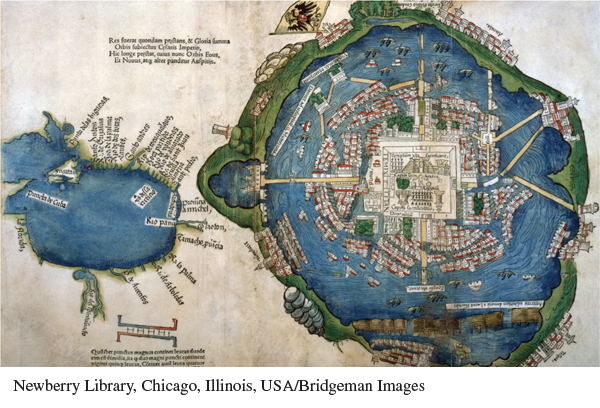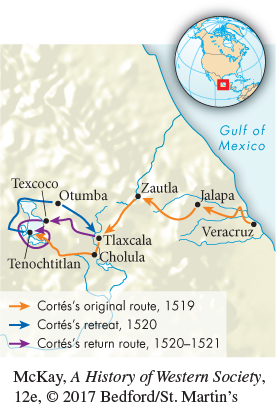A History of Western Society: Printed Page 440
A History of Western Society, Value Edition: Printed Page 424
A History of Western Society, Concise Edition: Printed Page 442
Spanish Conquest of the Aztec and Inca Empires
The first two decades after Columbus’s arrival in the New World saw Spanish settlement of Hispaniola, Cuba, Puerto Rico, and other Caribbean islands. Based on rumors of a wealthy mainland civilization, the Spanish governor in Cuba sponsored expeditions to the Yucatán coast of the Gulf of Mexico, including one in 1519 under the command of the conquistador Hernán Cortés (1485–1547). Alarmed by Cortés’s ambition, the governor decided to withdraw his support, but Cortés quickly set sail before being removed from command. Accompanied by 11 ships, 450 men, 16 horses, and 10 cannon, Cortés landed on the Mexican coast on April 21, 1519. His camp soon received visits by delegations of unarmed Aztec leaders bearing gifts and news of their great emperor.
The Aztec Empire, an alliance between the Mexica people and their conquered allies, had risen rapidly in size and power in the early fifteenth century. At the time of the Spanish arrival, the empire was ruled by Moctezuma II (r. 1502–1520), from his capital at Tenochtitlan (tay-

Within weeks of his arrival, Cortés acquired translators who provided vital information on the empire and its weaknesses (See “Thinking Like a Historian: Who Was Doña Marina?”) To legitimize his authority, Cortés founded the settlement of Veracruz and had himself named its military commander. He then burned his ships to prevent any disloyal or frightened followers from returning to Cuba.

The vulnerability Cortés discovered was local resentment against the Aztec Empire. The Aztec state practiced warfare against neighboring peoples to secure captives for religious sacrifices and laborers for agricultural and building projects. Once conquered, subject tribes paid continual tribute to the empire through their local chiefs. Realizing that he could exploit dissensions within the empire to his own advantage, Cortés forged an alliance with Tlaxcala (tlah-
Historians have long debated Moctezuma’s response to the arrival of the Spanish. Unlike other native leaders, he refrained from attacking the Spaniards but instead welcomed Cortés and his men into Tenochtitlan. Moctezuma was apparently deeply impressed by Spanish victories and believed the Spanish were invincible. Sources written after the conquest claimed that the emperor believed Cortés was an embodiment of the god Quetzalcoatl, whose return was promised in Aztec myth.
While it is impossible to verify those claims, it is clear that Moctezuma’s long hesitation proved disastrous. When Cortés — with incredible boldness — took Moctezuma hostage, the emperor’s influence crumbled. During the ensuing attacks and counterattacks, Moctezuma was killed. The Spaniards and their allies escaped from the city, suffering heavy losses. Cortés quickly began gathering forces and making new alliances against the Aztecs. In May 1521 he conducted a second assault on Tenochtitlan, leading an army of approximately one thousand Spanish and seventy-
Spanish victory in late summer 1521 was hard-
More surprising than the defeat of the Aztecs was the fall of the remote Inca Empire. Perched more than 9,800 feet above sea level, the Incas were isolated from North American indigenous cultures and knew nothing of the Aztec Empire or its collapse. Like the Mexica, the Incas had created a polity that rivaled that of the Europeans in population and complexity. The Incas’ strength lay largely in their bureaucratic efficiency. They divided their empire into four major regions containing eighty provinces and twice as many districts. Officials at each level used an extensive network of roads to transmit information and orders back and forth through the empire. While the Aztecs used a system of glyphs for writing, the Incas had devised a complex system of colored and knotted cords, called khipus, for administrative bookkeeping. The empire also benefited from the use of llamas as pack animals (by contrast, no beasts of burden existed in Mesoamerica).
By the time of the Spanish invasion, however, the Inca Empire had been weakened by a civil war over succession and an epidemic of disease, possibly smallpox, which may have spread through trade with groups in contact with Europeans. Francisco Pizarro (ca. 1475–1541), a conquistador of modest Spanish origins, landed on the northern coast of Peru on May 13, 1532, the very day the Inca leader Atahualpa (ah-
Like Moctezuma in Mexico, Atahualpa was aware of the Spaniards’ movements. He sent envoys to invite the Spanish to meet him in the provincial town of Cajamarca. His plan was to lure the Spanish into a trap, seize their horses and ablest men for his army, and execute the rest. With an army of some forty thousand men stationed nearby, Atahualpa felt he had little to fear. Instead, the Spaniards ambushed and captured him, collected an enormous ransom in gold, and then executed him in 1533 on trumped-
How was it possible for several hundred Spanish conquistadors to defeat powerful empires commanding large armies, vast wealth, and millions of inhabitants? Historians seeking answers to this question have emphasized a combination of factors: the boldness and audacity of conquistadors like Cortés and Pizarro; the military superiority provided by Spanish firepower and horses; divisions within the Aztec and Inca Empires, which produced many native allies for the Spanish; and, of course, the devastating impact of contagious diseases among the indigenous population. Ironically, the well-